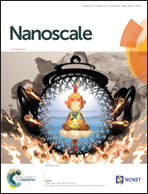Highly durable and cycle-stable lithium storage based on MnO nanoparticle-decorated 3D interconnected CNT/graphene architecture†
Abstract
To accommodate huge volume change and boost the inferior electrochemical reaction kinetics of manganous oxide anodes for lithium-ion batteries, a unique 3D porous CNT/graphene–MnO architecture has been synthesized, with MnO nanoparticles homogeneously decorated on 3D interconnected CNT/graphene (3DCG) conductive networks. This porous 3DCG matrix with its abundant open pores and large surface area can provide efficient channels for fast charge transport and allow full contact between the electrode and electrolyte, leading to improved electrochemical activity. The robust 3D architecture offers abundant stress buffer space to tolerate volume expansion and ensures robust structural stability during the electrochemical processes. The synergistic effect between components endows the 3DCG/MnO electrodes with excellent electrochemical performance, retaining a high specific capacity of 526.7 mA h g−1 at 2.0 A g−1 with 98% capacity retention over 1400 cycles. This work provides a promising route for the practical application of fast and durable lithium-ion batteries and suggests insights for rational structural designs with other transition metal oxides.



 Please wait while we load your content...
Please wait while we load your content...